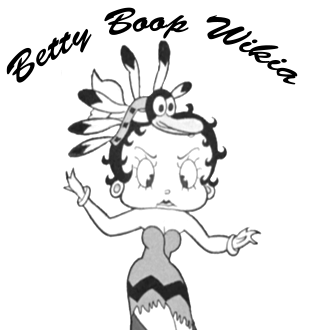Anime
Porco Rosso
Hayao Miyazaki is outspoken about his admiration of the vintage American animation company, Fleischer Studios. In 1979, Miyazaki wrote a review of Fleischer's Mister Bug Goes to Town in great detail, "I like Fleischer works. And when I say ‘Fleischer,’ I do not mean Dave Fleischer the individual, but the whole animation staff, which probably included members both young and old and represented an entire trend in animation that is symbolized by the word Fleischer." Though he did not enjoy the outcome of Mister Bug Goes to Town, Miyazaki greatly enjoyed the gags from Popeye and particularly finds Betty Boop amusing. He paid tribute to Fleischer Studios and Disney's 1928 short Plane Crazy in a sequence from Porco Rosso, where Porco watches a short animated film in a local theater. In the cartoon sequence, the damsel in distress gives off a resemblance to Olive Oyl and Betty Boop.
Tengu Taji
The male protagonist who appears in Tengu Taji (1934) somewhat resembles Betty Boop. The cartoon also takes minor elements from the Betty Boop cartoon series.
Mabo no Daikyoso - Mabo's Big Race (マー坊の大競争)
Betty Boop makes a cameo in 1936 alongside Mickey Mouse, Minnie Mouse and Felix the Cat in Mabo's Big Race. The Japanese flag rises on the center pole, flanked by two Olympic Games flags. People cheer and wave Japanese flags in the audience. Next up, it is the pole vault. Mābō’s competitor knocks down the bar on his first run, but Mābō sails over the bar with ease. In his second try, Mābō runs into trouble, but his pole becomes anthropomorphic and aggressively shoves him over the pole and into first place again. The image of the Japanese waving flags repeats and the film ends abruptly on a close up of a standalone Japanese flag. In Mābō’s Big Race, America was not yet Japan's enemy so Mickey and Minnie Mouse, Betty Boop, and Felix the Cat are merely signifiers of the mostly Western crowds that would be in attendance at the XI Olympics.
Momotaro no Umiwashi - Momotaro's Sea Eagles (桃太郎の海鷲)
Bluto from the Popeye the Sailorman series appears in the 1943 animated film as a stereotypical drunk. Which is one of few examples of the Axis nations using American cartoon characters to portray the United States in animation, just as the Allied forces used Hitler, Mussolini, and Hirohito, as well as Nazis and Japanese soldiers in their propaganda films. The posters also suggest that Momotaro's army will not only be fighting Bluto but also Popeye and Betty Boop, declaring: "Roosevelt and the American gangster Popeye are no match." Popeye and Betty appear in the advertisement for the animation where they can be seen drowning. Although Betty was cast as an enemy of Japan, she was still a popular box office draw.
Dr Slump
In the 1980s anime Dr Slump, character Kinoko Sarada's mother slightly looks like Betty Boop. Whereas in the original manga she resembled Fujiya Co.'s mascot Peko-chan.
Creamy Mami the Magic Angel
Betty Boop is referenced in the anime Creamy Mami the Magic Angel (魔法の天使クリィミーマミ Mahō no Tenshi Kurīmī Mami), in the episode "Yuu's Flashdance". Yuu's mother and father are watching a game show, the host asks, "If a female artist has MM as initials that would stand for Marilyn Monroe. What does BB stand for?" Yuu's mother replies, "That's really dumb. It's Betty Boop right?"
Princess Knight
Osamu Tezuka (手塚 治虫), best known for creating Astro Boy, was inspired by Betty Boop[1] and Disney films such as Bambi and Snow White and the Seven Dwarfs. He was also a fan of many American cartoon studios, and studied them. Princess Sapphire's hairstyle seems to resemble Betty Boop's, though the character was based on actress Chikage Awashima. In the sequel Sapphire gives birth to twins, Prince Daisy and Princess Violetta, who also both sport a similar hairstyle to Betty Boop.
"Love To Live By (M-Flo Loves Chara)"
The Japanese hip hop group M-Flo (エムフロウ) and Japanese pop star Chara (綿引美和) collaborated to make a song called "Love To Live By (M-Flo Loves Chara)", which has an animated music video. The video features Chara singing as a character whose design is based off of Betty Boop, with elements from Tex Avery. The video itself is in black and white (up to a point) and all the characters are drawn and animated in a way that mimics both old black and white cartoons and anime.
Urusei Yatsura
Betty Boop appears in episode 64 of Urusei Yatsura (うる星やつら) on the front cover of a book on the English language, with her first name also appearing on one side of the cover.






















